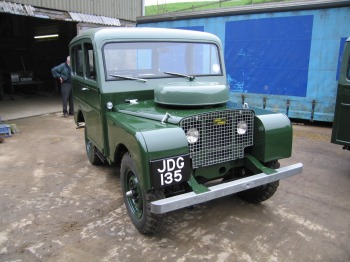HOME |
 |
 SHOP ON-LINE AT OPTICAL AND HEARING To advertise |
HOME |
 |
 SHOP ON-LINE AT OPTICAL AND HEARING To advertise |
 |
|
1st July, 2005 The Heritage Motor Centre in Warwickshire England yesterday took possession of a rare Land Rover - it is thought that only 20 such vehicles survive today. The 1949 Land Rover Series 1 station wagon was offered to the museum by a private collector and will go on display within the Land Rover collection at Gaydon. "We are absolutely delighted to have this particular vehicle in the museum, not only is it a rare specimen, but it has been well cared for and protected over the years and sensitively restored by the owner, it is in excellent condition. Visitors to the museum will be able to see the vehicle on show from today (Thursday)," said Stephen Laing, Curator of the museum. The museum is open daily (except 24-26 Dec) from 10 a.m. to 5 p.m. Entrance fees: £8 Adults, £7 Concessions, £6 children (5-16) under fives are free. Visitors can take a ride on the Land Rover off-road experience at the Centre during weekends and school holidays. HISTORY: The Tickford Land Rover followed shortly after the launch of the original Land Rover in 1948. The station wagon gave the impression of a more commercial vehicle, although it was not regarded as such by the Exchequer and unfortunately attracted hefty Purchase Tax, which made it expensive causing the inflated purchase price of £959, compared to the exempt of tax ‘farmer's friend’ the Series 1 at £580. The original Land Rover Series 1 quickly established itself as a most competent vehicle for a wide variety of off-road application. The Solihull car manufacturer – Rover, realised that there might be a market for a more comfortable model, where the car could be used on the road or to transport people, whilst still being as capable as its basic counterpart. The coachbuilder Tickford was commissioned to design the new model – to be known as the station wagon – and conceived an all-metal rear body on a wooden frame. Inside there was space for seven people, with the addition of four folding seats in the rear, which could be removed for extra storage space. Access for those in the rear was by the front passenger door and at the back there was a split, folding tailgate. The body was finished to a high standard, with a larger single piece windscreen, winding windows and even a metal cover to protect the bonnet mounted spare wheel. By the end of production in 1951, only 641 station wagons had been produced and more than 600 of these had been exported. It is thought that only about 20 survive today.
|
